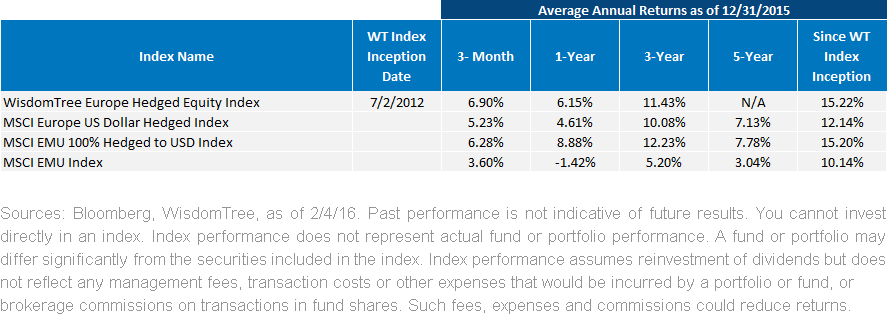Price Returns, Total Returns and Currency Hedged Equity ETFs


 For definitions of indexes in the chart, visit our glossary.
WisdomTree did underperform one European hedged index in calendar year 2015. That can occur when you have different country and sector weights compared to the “beta” benchmarks. But those variations can also turn in your favor. Thus far in 2016, WisdomTree’s Europe Hedged Equity Index has already generated more than 150 basis points (bps) of excess return relative to this MSCI EMU 100% Hedged Index —so that trailing one-year performance differential is closing.
Price Returns vs. Total Returns
WisdomTree, like most ETF managers, provides return data on its website (click here to see standardized returns for HEDJ). Regrettably, many investors (and some financial reporters) use data from vendors that show returns based only on the ETF’s price movement in the market. This can cause confusion. To make meaningful fund comparisons, investors should use the total return of an ETF, which can include reinvested dividends, interest and capital gains distributions. Investors who look at Yahoo Finance or their own brokerage screens may not see the full performance picture if they only view the “price” return of the fund. HEDJ, for example, generated a total return of 6.7% at Net Asset Value (NAV) in the fourth quarter of 2015. But the capital gains distributions and the dividends it paid in that quarter totaled $4.00 per share—or roughly 7% of the fund’s NAV. If you were looking at a screen that did not include those distributions, you could mistakenly conclude that HEDJ lost money over the final three months of 2015. It didn’t. To the contrary, it literally put money in investors’ pockets.
Capital Gains on Currency-Hedged Equity Funds
Many equity ETFs can go many years before ever paying a capital gains distribution to shareholders. This tax efficiency is one of the benefits of the ETF structure. However, currency-hedged equity funds that generate positive returns through the use of forward contracts do typically generate capital gains distributions. This was the case for HEDJ in 2015. WisdomTree generated zero capital gains on the equity portion of the portfolio. But HEDJ did make a large capital gains distribution in December because the Fund succeeded in doing exactly what it was designed to do: It mitigated the impact of the euro. The Fund does this each month by entering into forward contracts to establish a short position in the euro. This is intended to hedge the impact of being “long” the euro by owning European stocks. Because most of the euro’s depreciation in 2015 occurred earlier in the year, and because HEDJ has a different fiscal year than other European hedged ETFs, HEDJ produced a larger capital gains distribution on its currency forward contracts—both in absolute dollar terms and as a percentage of NAV.2 In any given year, the size of capital gains distributions can vary; next year it could easily reverse.
Costs of Trading Currency-Hedged ETFs
Another misperception around currency-hedged ETFs relates to the cost of hedging and the cost of trading the ETF in the marketplace. The cost of hedging typically is determined by the differential in interest rates between the foreign currency and the U.S. dollar. Right now that cost is nil. With short-term interest rates in Europe below zero as of June 2014, that differential actually represents a source of return for U.S. investors.
In addition to the management fee, the other costs incurred by ETF investors relate to brokerage commissions and the bid/ask spread to buy the ETF on an exchange. The cost to create or redeem an ETF can vary, but that is a cost borne by large institutions that transact with the Fund and is not necessarily a cost that investors buying on an exchange incur directly. It is fair to say that the cost of assembling the basket of stocks within an ETF is typically reflected in the bid/ask spread in the ETF. But in ETFs that are actively traded, that cost can dissipate with strong two-way flow in the secondary market .
HEDJ is one of those actively traded ETFs. It traded an average of more than 5 million shares per day over the last three months, or roughly five times the average daily dollar volume of its closest competitors over that period.3 Because of that two-way flow, HEDJ typically trades a penny wide between the bid and ask price. If you trade a penny wide at $50, the cost per trade is 2 basis points, excluding commission costs. That compares to 4 basis points for funds trading a penny wide at half of HEDJ’s price.4
For many investors, the all-in cost of owning and trading an ETF—as well as its total return over time—is what really matters.
1Source: Morningstar, as of 12/31/15.
2Source: WisdomTree, as of 1/29/16.
3Source: Bloomberg.
4Source: ETF.com.
For definitions of indexes in the chart, visit our glossary.
WisdomTree did underperform one European hedged index in calendar year 2015. That can occur when you have different country and sector weights compared to the “beta” benchmarks. But those variations can also turn in your favor. Thus far in 2016, WisdomTree’s Europe Hedged Equity Index has already generated more than 150 basis points (bps) of excess return relative to this MSCI EMU 100% Hedged Index —so that trailing one-year performance differential is closing.
Price Returns vs. Total Returns
WisdomTree, like most ETF managers, provides return data on its website (click here to see standardized returns for HEDJ). Regrettably, many investors (and some financial reporters) use data from vendors that show returns based only on the ETF’s price movement in the market. This can cause confusion. To make meaningful fund comparisons, investors should use the total return of an ETF, which can include reinvested dividends, interest and capital gains distributions. Investors who look at Yahoo Finance or their own brokerage screens may not see the full performance picture if they only view the “price” return of the fund. HEDJ, for example, generated a total return of 6.7% at Net Asset Value (NAV) in the fourth quarter of 2015. But the capital gains distributions and the dividends it paid in that quarter totaled $4.00 per share—or roughly 7% of the fund’s NAV. If you were looking at a screen that did not include those distributions, you could mistakenly conclude that HEDJ lost money over the final three months of 2015. It didn’t. To the contrary, it literally put money in investors’ pockets.
Capital Gains on Currency-Hedged Equity Funds
Many equity ETFs can go many years before ever paying a capital gains distribution to shareholders. This tax efficiency is one of the benefits of the ETF structure. However, currency-hedged equity funds that generate positive returns through the use of forward contracts do typically generate capital gains distributions. This was the case for HEDJ in 2015. WisdomTree generated zero capital gains on the equity portion of the portfolio. But HEDJ did make a large capital gains distribution in December because the Fund succeeded in doing exactly what it was designed to do: It mitigated the impact of the euro. The Fund does this each month by entering into forward contracts to establish a short position in the euro. This is intended to hedge the impact of being “long” the euro by owning European stocks. Because most of the euro’s depreciation in 2015 occurred earlier in the year, and because HEDJ has a different fiscal year than other European hedged ETFs, HEDJ produced a larger capital gains distribution on its currency forward contracts—both in absolute dollar terms and as a percentage of NAV.2 In any given year, the size of capital gains distributions can vary; next year it could easily reverse.
Costs of Trading Currency-Hedged ETFs
Another misperception around currency-hedged ETFs relates to the cost of hedging and the cost of trading the ETF in the marketplace. The cost of hedging typically is determined by the differential in interest rates between the foreign currency and the U.S. dollar. Right now that cost is nil. With short-term interest rates in Europe below zero as of June 2014, that differential actually represents a source of return for U.S. investors.
In addition to the management fee, the other costs incurred by ETF investors relate to brokerage commissions and the bid/ask spread to buy the ETF on an exchange. The cost to create or redeem an ETF can vary, but that is a cost borne by large institutions that transact with the Fund and is not necessarily a cost that investors buying on an exchange incur directly. It is fair to say that the cost of assembling the basket of stocks within an ETF is typically reflected in the bid/ask spread in the ETF. But in ETFs that are actively traded, that cost can dissipate with strong two-way flow in the secondary market .
HEDJ is one of those actively traded ETFs. It traded an average of more than 5 million shares per day over the last three months, or roughly five times the average daily dollar volume of its closest competitors over that period.3 Because of that two-way flow, HEDJ typically trades a penny wide between the bid and ask price. If you trade a penny wide at $50, the cost per trade is 2 basis points, excluding commission costs. That compares to 4 basis points for funds trading a penny wide at half of HEDJ’s price.4
For many investors, the all-in cost of owning and trading an ETF—as well as its total return over time—is what really matters.
1Source: Morningstar, as of 12/31/15.
2Source: WisdomTree, as of 1/29/16.
3Source: Bloomberg.
4Source: ETF.com.
Important Risks Related to this Article
Dividends are not guaranteed, and a company currently paying dividends may cease paying dividends at any time.
There are risks associated with investing, including the possible loss of principal. Foreign investing involves special risks, such as risk of loss from currency fluctuation or political or economic uncertainty. Investments in currency involve additional special risks, such as credit risk and interest rate fluctuations. Derivative investments can be volatile, and these investments may be less liquid than other securities, and more sensitive to the effects of varied economic conditions. As this Fund can have a high concentration in some issuers, the Fund can be adversely impacted by changes affecting those issuers. Due to the investment strategy of this Fund, it may make higher capital gain distributions than other ETFs. Please read the Fund’s prospectus for specific details regarding the Fund’s risk profile.


